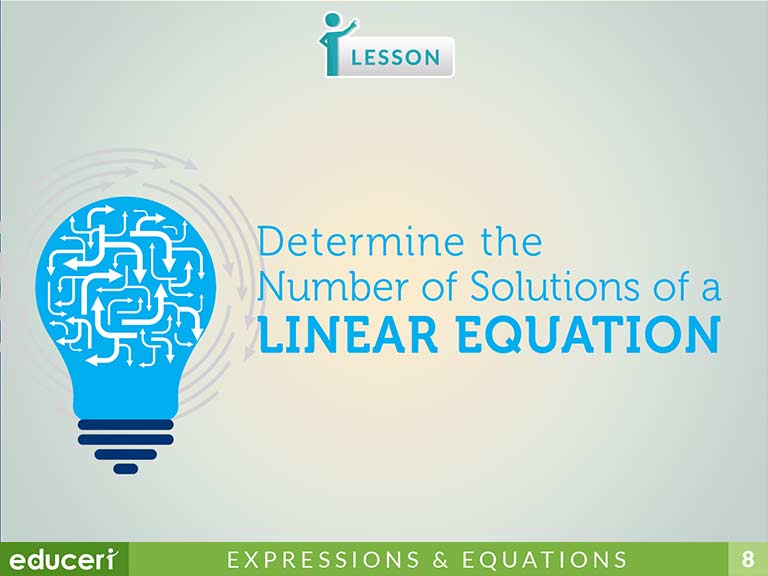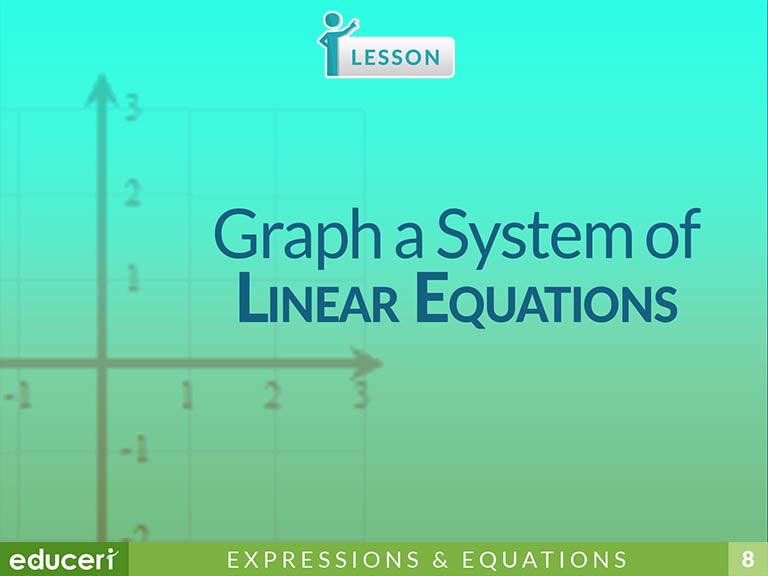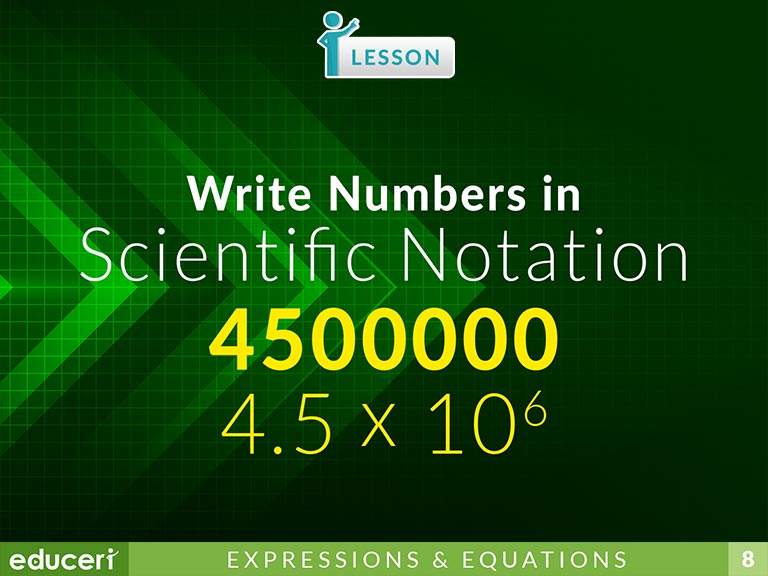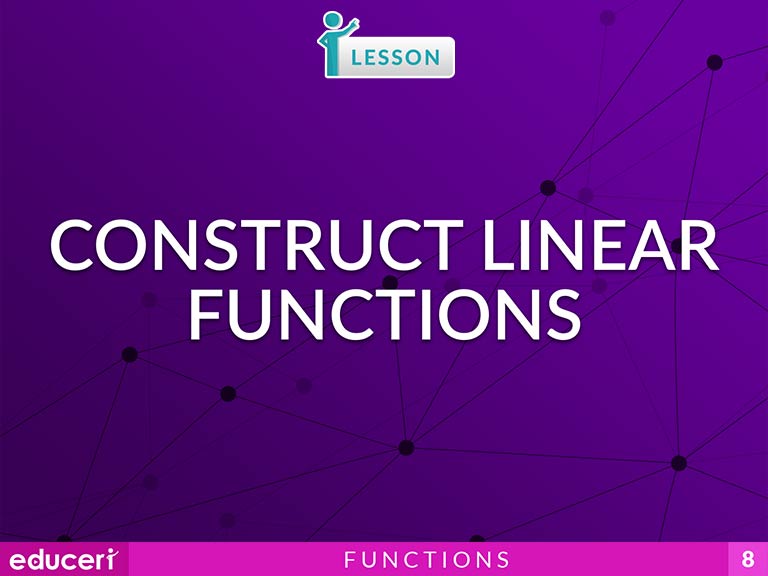All Lessons

Determine the Number of Solutions of a Linear Equations
8.EE.7 Solve linear equations in one variable.
8.EE.7.A8.EE.7.A Give examples of linear equations in one variable with one solution, infinitely many solutions, or no solutions. Show which of these possibilities is the case by successively transforming the given equation into simpler forms, until an equivalent equation of the form x = a, a = a, or a = b results (where a and b are different numbers).
This expressions and equations lesson teaches students how to determine the number of solutions of a linear equation. The lesson includes research-based strategies and strategic questions that prepare students for assessments. In this lesson, students will find the solution to a linear equation. Students will determine whether the linear equation has one solution, infinite solutions, or no solution.
Share This Lesson

Solve Multistep Equations
This expressions and equations lesson teaches students how to solve multistep equations. The lesson includes research-based strategies and strategic questions that prepare students for assessments. In this lesson, students will solve equations that require three or more steps. Students will perform a variety of inverse operations to isolate the variable and determine the solution.
Share This Lesson

Graph a System of Linear Equations
(Y8) Solve linear equations using algebraic and graphical techniques. Verify solutions by substitution (ACMNA194)
ACMNA237(Y10) Solve linear simultaneous equations, using algebraic and graphical techniques, including using digital technology (ACMNA237)
8.EE.8 Analyze and solve pairs of simultaneous linear equations.
8.EE.8.A8.EE.8.A Understand that solutions to a system of two linear equations in two variables correspond to points of intersection of their graphs, because points of intersection satisfy both equations simultaneously.
8.EE.8.B8.EE.8.B Solve systems of two linear equations in two variables algebraically, and estimate solutions by graphing the equations. Solve simple cases by inspection. For example, 3x + 2y = 5 and 3x + 2y = 6 have no solution because 3x + 2y cannot simultaneously be 5 and 6.
This expressions and equations lesson teaches students how to interpret the solutions of systems of linear equations. The lesson includes research-based strategies and strategic questions that prepare students for assessments. In this lesson, students will interpret the solutions of systems of linear equations. Students will interpret a variety of systems of linear equations including several real-world word problems.
Share This Lesson

Determine the Slope of a Line Using the Slope Formula
This algebra and functions lesson focuses on determining the slope of a line using the slope formula. The lesson includes research-based strategies and strategic questions that prepare students for assessments. In this lesson, students label the points as x1, y1, and x2, y2. Then, they substitute the y- and x- values into the slope formula. Finally, they determine the slope of the line and interpret it by identifying the direction of the line. In addition to the lesson, there are five pages of Independent Practice and review with questions modeled after current adaptive testing items.
Share This Lesson

Determine the Slope of a Line Using the Slope Formula
This expressions and equations lesson teaches students how to determine the slope of a line using the slope formula. The lesson includes research-based strategies and strategic questions that prepare students for assessments. In this lesson, students will determine the slope of a line using the slope formula.
Share This Lesson

Determine the Equation of a Line Using Slope-Intercept Form
Share This Lesson

Determine if a Function is Linear
This functions lesson teaches students how to determine if a function is linear. The lesson includes research-based strategies and strategic questions that prepare students for assessments. In this lesson, students will learn to determine whether or not a function is linear or not. Students will look at a wide variety of functions, graphs, and ordered pairs to determine whether they describe linear functions.
Share This Lesson

Graph Cubic Functions
This algebra and functions lesson focuses on graphing cubic functions. The lesson includes research-based strategies and strategic questions that prepare students for assessments. In this lesson, students substitute each value into the cubic equation and solve. Then, they plot the ordered pairs and connect the points using a smooth, curved line. In addition to the lesson, there are five pages of Independent Practice and review with questions modeled after current adaptive testing items.
Share This Lesson

Graph Quadratic Functions
This algebra and functions lesson focuses on graphing functions of the form y=nx^2. The lesson includes research-based strategies and strategic questions that prepare students for assessments. In this lesson, students identify and label the coefficient, n, of the quadratic function. Then, using n, they describe whether the parabola opens upward or downward and complete the table with x- and y-values by evaluating each function for the ex-values in the table. Finally, they use the table to create ordered pairs and plot them on the coordinate grid and sketch the parabola. In addition to the lesson, there are four pages of Independent Practice and review with questions modeled after current adaptive testing items.
Share This Lesson

Reflect Geometric Figures
8.G.1 Verify experimentally the properties of rotations, reflections, and translations:
8.G.1.A8.G.1.A Lines are taken to lines, and line segments to line segments of the same length.
8.G.1.B8.G.1.B Angles are taken to angles of the same measure.
8.G.1.C8.G.1.C Parallel lines are taken to parallel lines.
This geometry lesson teaches students how to reflect geometric figures. The lesson includes research-based strategies and strategic questions that prepare students for assessments. In this lesson, students will reflect geometric figures across lines. Students will reflect a wide variety of different geometric figures.
Share This Lesson

Rotate Geometric Figures
8.G.1 Verify experimentally the properties of rotations, reflections, and translations:
8.G.1.A8.G.1.A Lines are taken to lines, and line segments to line segments of the same length.
8.G.1.B8.G.1.B Angles are taken to angles of the same measure.
8.G.1.C8.G.1.C Parallel lines are taken to parallel lines.
This geometry lesson teaches students how to rotate geometric figures. The lesson includes research-based strategies and strategic questions that prepare students for assessments. In this lesson, students will rotate geometric figures. This lesson can be used with rulers and protractors or with geometric software.
Share This Lesson

Translate Geometric Figures
8.G.1 Verify experimentally the properties of rotations, reflections, and translations:
8.G.1.A8.G.1.A Lines are taken to lines, and line segments to line segments of the same length.
8.G.1.B8.G.1.B Angles are taken to angles of the same measure.
8.G.1.C8.G.1.C Parallel lines are taken to parallel lines.
This geometry lesson teaches students how to translate geometric figures. The lesson includes research-based strategies and strategic questions that prepare students for assessments. In this lesson, students will translate geometric figures. Students will also verify the properties of translated figures. This lesson can be used with rulers and protractors or with geometric software.
Share This Lesson

Apply the Pythagorean Theorem (Unknown Side Length)
This geometry lesson teaches students how to apply the Pythagorean Theorem to determine unknown side lengths in a right triangle. The lesson includes research-based strategies and strategic questions that prepare students for assessments. In this lesson, students will use the Pythagorean Theorem to find the lengths of the sides of a triangle. This lesson also includes real-world word problems.
Share This Lesson

Use Properties of Parallel Lines Cut by a Transversal
This congruence lesson teaches students how to use the properties of parallel lines cut by a transversal. The lesson includes research-based strategies and strategic questions that prepare students for assessments. In this lesson, students will identify angle pairs as alternate/corresponding/interior/exterior angles and determine congruence.





